

European
Nuclear Society
e-news
issue 41: August 2013
http://www.euronuclear.org/e-news/e-news-41/sg-contribution.htm
I hope that you have enjoyed (or are still enjoying) your summer break and are feeling rested, refreshed and raring to go. As you know, these are challenging times for the European nuclear research community and we will need all our energy, focus and enthusiasm to meet the challenges ahead.
|
A few weeks ago I was fortunate to have the opportunity to visit a historical site: the location of the EBR-1 nuclear reactor, the first ever nuclear reactor to produce electricity, back in 1951. At the reactor site visitors can observe a row of incandescent light bulbs. The light that was first emitted from those light bulbs testified to the success of that pioneering project. The EBR-1 was an operational fast neutron reactor, with a sodium-potassium coolant. Ten years later it demonstrated how plutonium can be used as a suitable nuclear fuel. The reactor’s core later experienced a partial meltdown - every scenario was tested, the lessons from every experience were learnt! I couldn’t help making the connection between the EBR-1 and the |
|---|
experimental Solar Impulse aircraft, which will soon set off on its epic flight around the world. The power capacity of its two engines is rather limited and critics have been quick to ridicule the misplaced ambition and “dreams of glory” of the project’s promoters. And yet, in the space of fifty years nuclear energy succeeded in imposing itself as an essential energy source in a number of countries. Solar energy will doubtless overcome the doubters and play a similarly significant role over the next few decades.
In both cases, the teams of scientists and engineers that were involved in the EBR-1 and Solar Impulse projects (and in the latter case still are today) dared to go beyond the well-trodden paths and frontiers of accepted science and to explore new techniques that had never been dreamt of before. Both teams showed how they were driven and motivated by a similar passionate quest for progress, progress fuelled by discovery. By going beyond where anyone had been before they succeeded in changing the world.
As the debate about the merits and disadvantages of nuclear energy carries on unabated I am struck by the obscurantism of many opponents of nuclear energy. They seem to think that the world is static; that R&D is destined to bear no fruit and that technology and progress have gone their separate ways – never to be reunited. In actual fact, the opposite is true: science has never been so demonstrative of success and the relentless increase in the world’s population continues to present the scientific community with unprecedented challenges.
Of course, as the proverb goes, “science without conscience will destroy the soul.” Technological progress, therefore, requires us to make conscious societal choices that are the result of careful consideration, exhaustive discussion and, hopefully, consensus. ENS contributes to this vital process by mobilising the European nuclear community and engaging them in the on-going debate about the fundamental issues that the application of nuclear energy raises, especially with regards to medicine, industry, transport, the conquest of space etc. This culture of encouraging debate is essential. And it’s up to each and every one of us to play our part in it.
http://www.euronuclear.org/e-news/e-news-41/enygf.htm

It is interesting to be a part of an international conference that gathers together young professionals from the nuclear sector from all over the world. The European Nuclear Young Generation Forum 2013 (ENYGF) took place from 17-20 June in Stockholm, Sweden and welcomed over 300 participants from 23 countries, mostly from Europe. The ENYGF is a biennial conference organized alternately with International Youth Nuclear Congress (IYNC). It provides a great opportunity to discuss, every other year, the crucial nuclear issues of the day and each time in a different continent (Europe, Asia, America or Africa).
This year the ENYGF 2013 organisers offered a diverse programme dedicated to three main subjects: operating nuclear power plants, decommissioning and waste and nuclear power in the future. Participants were able to choose between different parallel technical sessions, 17 interactive workshops and sessions organized within the framework of what is called an “unconference”. The idea of the “unconference” is that the conference delegates decide which topic should be discussed and write a proposal on a flipchart. Each of the participants has the opportunity to either subscribe to the proposed subject or suggest a new one. This participant-driven concept offers more flexibility for discussions and teamwork projects.
ENYGF 2013 was opened by the representatives of the two main conference sponsors: Vattenfall and Westinghouse. First, Torbjörn Wahlborg, Senior Executive Vice President and Head of BD Nuclear Power at Vattenfall AB, underlined in his welcoming speech that the future of the nuclear industry depends on talented, well-trained and empowered young professionals. Furthermore, he talked about the importance of nuclear safety: “there is no competition between safety standards and being competitive”.
Second, Yves Brachet, President, Europe, Middle East and Africa, Westinghouse Electric Company, recalled the greatest achievements of electricity and nuclear power. He stressed that the nuclear young generation is facing two main challenges in the nuclear sector: economic competitiveness and public acceptance.
The first day of the conference concluded with a formal dinner in the magnificent venue of the Vasa Museum. During the dinner delegates were able to a tast a range of of Swedish gastronomic specialties. Also present were high level representatives of the Swedish nuclear industry, as well as Marco Streit, ENS President and Milo Alani, Chairman of ENS-YGN, who awarded Professor Heikki Kalli from Finland the Jan Runermark Award. This award is presented to an individual in recognition of his outstanding service to the the young nuclear generation.

On 18 June, delegates were able to choose from seven technical visits. During a one-day trip to Westinghouse Electric Sweden, in Västerås, I visited one of the world’s largest nuclear fuel factories, as well as the service centre and fuel test laboratory. It was interesting to see how the fuel assemblies for PWRs and BWRs are manufactured and handled.
On 19 June, ENS and ENS–YGN offered ENYGF 2013 delegates a chance to participate in an interactive workshop entitled Knowledge Transfer and New Tools. After a short introduction to traditional educational tools and e-learning options three speakers presented the different E&T activities of their organisations. Tatiana Karseka from IAEA explained the meaning of knowledge transfer and management and good practices recommended by the IAEA in this area. Javier Nieto from Tecnatom, presented four different full-scope simulators, including a 3D one, that are used during training courses offered by Tecnatom. Finally, Mattias Lanzelot, from Uppsala University, gave a lecture on nuclear physics with a use of clickers - an interactive tool which helps the students and teachers to check if the course was understandable.
On the penultimate and final day of this young professionals' conference, two particularly inspiring presentations were given. One was by Sigval Berg, from the USA, who has held various leading positions at American NPPs, INPO and WANO, and the other was by Mr and Mrs Jackson from Sweden, who hold senior positions at Swedish energy companies. Sigval Berg offered a fresh look at leadership, which he said should be viewed by young career-oriented professionals with selfless courage and consideration for those will follow after them.
Åsa and Anders Jackson then explained the importance of keeping the correct balance between career and private life.
To summarize, ENYGF 2013 provided a unique platform for an open dialogue between young professionals and leaders of the nuclear sector. Participants in the conference contributed to interesting discussions, listened to inspiring lectures, took part in interactive workshops, enjoyed great social events and met new colleagues from all over Europe. Congratulations to the organisers! The next edition of ENYGF will take place in 2015, in Paris. I’m already looking forward to participating in this event!
For more information on ENYGF 2013, the programme content, speakers etc. please go to: www.enygf2013.com
Emilia Janisz, ENS
http://www.euronuclear.org/e-news/e-news-41/NESTet2013.htm


NESTet is designed to facilitate an exchange of information and the sharing of best practice. It is an important networking opportunity for better co-ordination and collaboration between different stakeholders in nuclear education.
The NESTet Programme will feature the following topics:
Setting the framework
What are the needs with regard to nuclear education and training?
Where are efforts on harmonisation needed?
What are the answers that help to close the gap?
What is the situation with regard to infrastructure and tools for nuclear education and training?
How to ensure that enough motivated workforce is available for the nuclear sector?
What are the interactions between nuclear education and civil society?
Centres of excellence academica and their Masters programmes
E&T needs for New Build and upgrade of existing plants
What are the experiences of countries with an emerging nuclear sector?
Young Generation Workshop on the use of new technologies for education and training
Programme is no available on www.nestet2013.org
NESTet 2013 Conference Secretariat
Fax: +32 2 502 3902
e-mail: nestet2013@euronuclear.org
http://www.euronuclear.org/e-news/e-news-41/PIME2014.htm


PIME is the annual meeting of communicators in the nuclear sector (industry, research, medical applications, education). It is the international gathering of nuclear communications professionals.
PIME is a unique opportunity to share experiences and best practices and get expert advice. The PIME 2014 programme will, among other things, include hands-on workshops on:
Social Media: how to engage and mobilise stakeholder groups through social media
Crisis Communications: towards a common pool of experience for the benefit of everyone
In order to organise highly interactive and practical workshops, the PIME 2014 Programme Committee is now looking for contributions for the workshops on social media and crisis communications. See the PIME 2014 Call for Contributions for more information.
MARK YOUR DIARY – Join us in Ljubljana from 16 – 19 February 2014
PIME 2014 Conference Secretariat
organised in collaboration with:
http://www.euronuclear.org/e-news/e-news-41/RRFM2014.htm


In 2014 the European Research Reactor Conference, RRFM, will take place from 30 March - 3 April 2014 in Ljubljana, Slovenia.
The RRFM 2014 Programme Committee is now calling for both oral and poster presentations regarding
All Key Areas of the Nuclear Fuel Cycle of Research Reactors
Utilisation of Research Reactors
Innovative methods in reactor physics and thermo-hydraulics
New Research Reactor Projects
Research Reactor Operation and Maintenance
Safety and Security of RR
Mark your diaries and be a part of it! Upload your abstracts on www.rrfm2014.org before 15 November 2013.
Authors should submit their abstract text in English through the Abstract Submission System on Reference number ISBN 978-92-95064-20-1 |
http://www.euronuclear.org/e-news/e-news-41/ENC2014.htm


The European Nuclear Conference (ENC) 2014 will take place from 11 – 15 May 2014 in Marseille, Provence, France.
ENC is the international get-together of nuclear science and industry in Europe. This European Nuclear Society (ENS) event has a multidisciplinary approach, looking at nuclear science and technology in energy production, non-power industrial and life science applications.
ENC 2014 will be a unique networking event for scientists, nuclear industry representatives and policy makers. Make sure you are a part of it and send us your abstract.
Join us in the most ancient city in France. Marseille Provence, Europe’s 2013 Capital of Culture, is a city of festive and colourful contrasts, where sunshine and business go hand in hand.
ENC 2014 Conference Secretariat
http://www.euronuclear.org/e-news/e-news-41/sne-news.htm

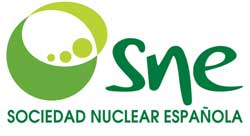
Spain's Nuclear Safety Council agreed on May 24th, 2013 to extend the deadline for the closure of the Garoña nuclear power plant. It will leave more time for the operator, Nuclenor, to potentially request the extension of the operating licence of Garoña, which is scheduled to stop working on July 6th 2013.
The 39thAnnual Meeting that will be held from 25th to 27th of Spetember of 2013 in Reus is already open for registration. All the relevant information about the meeting is available at: www.reunionanualsne.es.
The technical program includes three Plenary Sessions and two Monographic Sessions devoted to relevant current issues related to energy subjects or associated topics. The participants in these sessions include high ranking national and international experts in the topics covered by the sessions.
The Plenary Sessions will focus on currently important issues in the energy and nuclear
sectors such as:
• Training, a strategic key to the safe operation of nuclear power plants.
• Internationalization of the Spanish nuclear industry.
• Management and prioritization of regulatory requirements (roundtalbe format).
For Monograph Sessions have chosen the following two topics:
• Research in the nuclear sector.
• Electric power interconnections and security of supply.
The core of the technical program are the Technical Sessions and “Learn more about... Courses”, in which national and international professionals and experts present their work on relevant projects and scientific studies and on the progress made in the past year in different fields. The technical papers are presented in parallel oral sessions and poster sessions. The subjects of the papers cover a wide range of fields such as fission, maintenance, R&D, communication, legal aspects of nuclear power, medical
applications, etc.
This year “Learn more about...Courses” will be:
• The electricity market and the domestic bill.
• Human error prevention techniques in engineering works.
The meeting also includes activities aimed at informing and educating the general public, e.g. the Basic Course on Nuclear Science and Technology, which is organized by the SNE’s Nuclear Youth Committee and is open to students from the city and region and to anyone else who wishes to learn more about nuclear energy and technology.
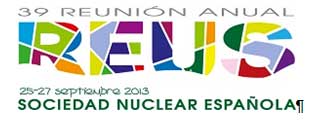
Young Nuclear Generation is pushing actively the education and training of young people, giving new editions of its Annual Seminar on Safety on Advanced Reactors, Basic Course of Nuclear Science and Technology at the ETS of Industrial Engineering of Polytechnic University of Madrid.
Nuclear España, the monthly magazine of SNE, published since 1984, has issued the editions 335th and 339th about the “38th Annual Meeting” and the winter session "Spanish Nuclear Power Plants in 2012. Experiences and Perspectives", in English and Spanish.
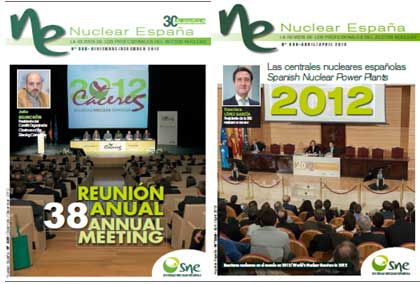
http://www.euronuclear.org/e-news/e-news-41/eced2013.htm

Good morning ladies and gentlemen,
It is an honour for me to be here today on behalf of the Slovak Nuclear Society and as Chairman of the ECED Program Cmmittee and to have the chance to address you at this Eastern and Central European Decommissioning 2013 conference.
We decided to organise an international conference focused on decommissioning and this event is the culmination of that effort. This key topic seems to have recently been given heightened importance by the decisions made by several governments in Europa to shut-down certain NPPs for a variety of different reasons. After the Fukushima accident and its impact on public opinion worldwide, European countries will doubtless consider decommissioning an increased the number of units and facilities.
We are pleased to note from your presence here today that you are genuinely interested in this important issue. We also appreciate that almost all important institutions and companies active in the Slovak or European nuclear power engineering and/or decommissioning sector are taking part in our conference and have delegated their most senior managers and experts to represent them here. This topical conference is organized under auspices of the Ministry of the Economy of the Slovak Republic. Our challenge is to make ECED2013 as stimulating, cost effective, and constructive for participants as possible, and thereby make it essential for you to join us for the next conferenc as well.
Nuclear safety and security are absolute priorities for the EU and this applies, of course, not only to NPPs operation but also to decommissioning activities. Nuclear decommissioning is already an industrial reality and the significant growth of the decommissioning market is to be further expected. Out of more than 560 nuclear power plants that have been built worldwide 130 reactors are permanently shut down. A large number of various types of research facilities have also become obsolete and have been shut down too. Today, only about 10% of all shut-down plants have been fully decommissioned, the rest being at different stages of safe enclosure, dismantling and decommissioning.
In the EU a total of 133 nuclear power plant units are currently in operation; about one third of them will have reached the end of their operational lifetime and will be in decommissioning by 2025. Moreover, after the disaster in Fukushima, Germany, one of Europe’s biggest operators of nuclear power, shut down 8 out of its 17 reactors and is committed to closing the rest by 2022. Other countries, including Japan, also envisage accelerating the closure of their oldest plants. This growing decommissioning market creates a potential for new activities, with highly skilled jobs in an innovative field, involving high-level technologies. A clear global positioning of the EU will stimulate the export of know-how to other countries, especially those having a large nuclear programme, and promote the highest safety levels. The EU "Community acquis" includes key legislation such as the recent COUNCIL DIRECTIVE 2011/70/EURATOM establishing the Community framework for the responsible and safe management of spent fuel and radioactive waste, which sets the legal obligations for adequate funding, financial security and transparency applicable to the national waste management systems.
Undoubtedly, strong regulatory supervision is of prime importance to ensure the successful decommissioning of nuclear facilities. The process for the regulatory control and licensing of the decommissioning activities may need to be further developed in some countries to cope with all safety concerns, including the radiological constraints associated with decommissioning, and to ensure optimal waste management.
Decommissioning activities generate large volumes of waste. In order to reduce their costs, environmental impact and the difficulties associated with the later disposal, emphasis has to be given to minimisation, sorting and characteristion. The most adequate processes for treatment and the most appropriate measurement techniques have to be developed and implemented.
The need to maintain and increase competent and qualified staff is a recurrent concern in the nuclear sector. In particular, in view of the growing decommissioning market, it can be expected that industry will involve new actors, including, in some cases, SMEs. The organiation of ad hoc training programs is also essential with a strong link to research and educational organiations.
We wish you all the best in the future and hope that you will enjoy a constructive, fruitful and enjoyable conference.
Vladimír Slugeň
SNUS President
http://www.euronuclear.org/e-news/e-news-41/snus.htm

The Slovak Nuclear Society (SNUS) recently organized an international conference for professionals involved in all stages of the decommissioning of nuclear facilities (planning, decontamination, dismantling, pre-disposal waste management, waste disposal) and their impact on the environment. The conference was held from June 18 to 20, in Trnava, western Slovakia. The title of the conference was Eastern and Central European Decommissioning (ECED). The main objective of the event was to encourage the exchange of experience and best practices in decommissioning of nuclear facilities in Central and Eastern Europe.
|
|
The main conclusions to emerge from the conference were summarized in the following closing remarks from the President of Slovak Nuclear Society and ECED Program Committee Chairman, Professor Vladimir Slugen:
"Ladies and gentlemen.
After 3 days of presentations and discussions we are approaching the end of our conference. In the afternoon some of you will take part in the technical tours to Jaslovske Bohunice to visit JAVYS technologies for rad-waste treatment. I hope you enjoyed the meeting and your stay in Trnava.
This year 164 participants were registered at the conference desk during all three days. About 1/3 of them came from abroad. In total 38 interesting and high-level quality oral presentations and 15 technical posters were presented.
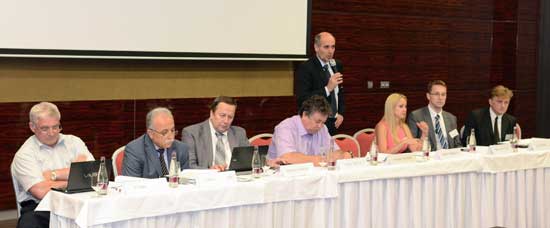
Panelists1: Mr Zimin (RUS), Mr Chaloyan (ARM), Mr Posiakin (RUS) and Mr Seyda (UKR)
The changes in the nuclear decommissioning sector that have taken place recently in Slovakia and Europe were discussed in detail. It was clearly said that decommissioning issues increase their importance and for many European countries this area is crucial for the social acceptance of nuclear by the public.
ECED2013 also touched upon sensitive problems associated with decommissioning activities, such as:
Financing of back-end cycle
National decommissioning strategies and programmes
Long-term fuel storage
International agreement Europe-wide for a common deep repository
Specialized education and training issues
Research, innovations and the application of new technologies
Public acceptance of decommissioning and rad-waste repositories
For Central and Eastern European countries that sometimes share very similar challenges two initiatives promise to be particularly beneficial for the future:
According to common experiences from VVER decommissioning – the creation of a master approach and procedures that could be recommended for VVER countries. NPP V-1 can be perhaps be the proper place for verification of these procedures.
Education, training and proper knowledge management have specific relevance for decommissioning. Based on the training courses that we run at the Slovak University of Technology we would like to create a European Academy for Decommissioning for VVER countries in collaboration with EC and IAEA. Knowledge and decommissioning skills could be shared on an international level. Input from several organisations present here at the conference woud be beneficial. We recommend tthat specific lessons, practical exercises and on-site training be organised at NPP V-1 in Jaslovske Bohunice, in English and in Russian.
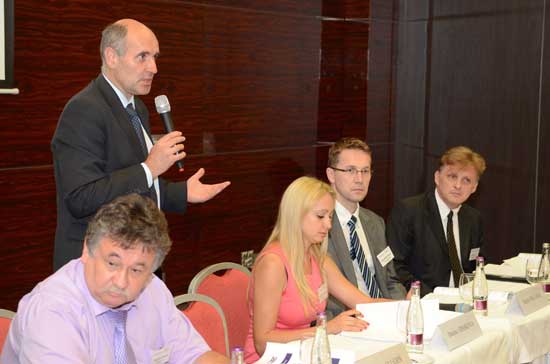
Panelists2: Mr Slugen (SVK), Mr Seyda (UKR), Ms Dishkova (BLG), Mr Macasek (SVK)
We will try to organize ECED here in Trnava on a biennial basis. I am looking forward to seeing you here in 2015.”
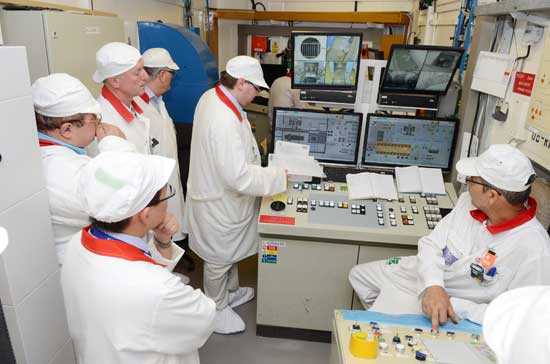
Technical visit to premises of Javys company
Prof. Vladimir Slugen
President of Slovak Nuclear Society and ECED Programme Committee Chairman
http://www.euronuclear.org/e-news/e-news-41/hungary.htm

The Joint Hungarian-Korean Laboratory for Advancement of Nuclear Thermal-Hydraulics Safety was opened in the Hungarian Academy of Sciences, Centre for Energy Research on 25 March 2013. Thermal hydraulic experiments will be carried out in the laboratory in order to simulate accident conditions in nuclear power plants. During the first year of the work programme the propagation of shock waves after a large break loss-of-coolant-accident will be simulated in the test facility. The experimental programme will be carried out by a joint team of Korean and Hungarian experts from the Korean Atomic Energy Research Institute and from the Hungarian Academy of Sciences, Centre for Energy Research.
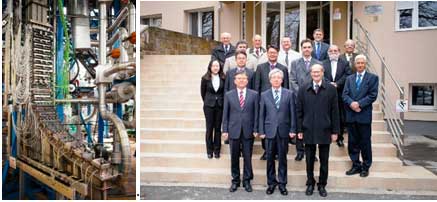
View of the thermal hydraulic facility (left) and the participants of the opening ceremony (right)
The Korean-Hungarian Joint Laboratory for Fusion Diagnostics was established at the Wigner Research Centre for Physics back in 2011 with the aim of jointly developing measurement systems (plasma diagnostics) for the KSTAR magnetic fusion facility in Daejeon, Korea. Some preparatory work started in 2010 with the construction of an experimental Beam Emission Spectroscopy (BES) system, which proved the viability of the technique for KSTAR in August 2011. This diagnostic works by observing the faint light emitter via a 100 keV deuterium atomic beam, heating the KSTAR plasma. The light intensity is nearly proportional to the plasma density, therefore information of the density distribution and plasma turbulence can be obtained. In 2011-12 a final BES system was constructed, installed and jointly operated. In 2012-13 this will be extended with the use of a low power 60 kV Lithium atomic beam injector, which should allow more precise measurements of the edge plasmas to be made.
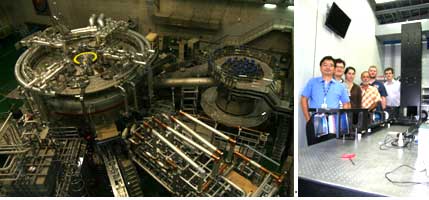
View of the KSTAR facility (left) and members of the joint team for fusion diagnostics (right)
The creation of the joint laboratories was supported by the Korea Research Council of Fundamental Science and Technology and by the Hungarian Academy of Sciences.
http://www.euronuclear.org/e-news/e-news-41/cns.htm

Both nuclear power plants (NPPs) in the Czech Republic - Dukovany and Temelin - are different when it comes to the middle part of the fuel cycle. While Dukovany has been using Russian fuel elements since beginning of its operation, Temelín initially used American fuel that was delivered together with I/C System by the US vendor Westinghouse. It also used a different methodological approach. This was the main reason why exchange of information between the NPPs was very formal at the beginning. Later, however, we recognised that in spite of the fact that the methodologies were different the problems encountered at both NPPs seemed to be very similar. These similarities led us to the idea of organising the first ever “face-to-face” exchange of information.
The first meeting took place in 2004 in Jarošov nad Nežárkou, a small village halfway between Temelín and Dukovany and was organized by the Dukovany Reactor Physic Department under the auspices of the Czech Nuclear Society. We invited our colleagues from Slovakian NPPs and they dispatched a small delegation consisting of two people from both Bohunice and Mochovce to take part as observers. The participation of Slovak colleagues inspired us to call this meeting ČMSSRF, which stands for the Bohemian-Moravian-Slovak Meeting of Reactor Physicists.
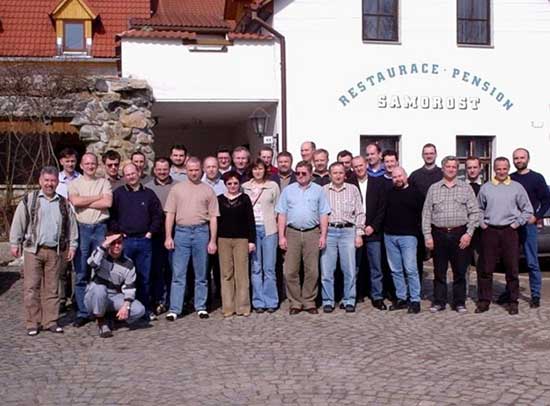
Photo 1: Participants in the first meeting in Jarošov (2004)
The presentations given at the meeting were divided into two parts. Part one, an informal exercise, consisted of everybody introducing himself or herself and of describing his/her own personal life (important personal jubilees such the anniversaries, children’s birthdays and the team building activities of his department). This became a tradition and subsequent meetings and starts with Temelín and Dukovany reactors physics department giving a funny presentation about the events of previous 12 months. The second part of presentations (more significant, formal and important) was devoted to an exploration of the current problems being experienced and of possible solutions.
The meeting was very useful both for us and our Slovak colleagues. So, we decided to organize this meeting on an annual basis, with responsibility for organising it alternating between Temelín and Dukovany. The second and the third meetings were held in České Budějovice and Třebíč, our “home” cities. We visited interesting towns and villages near the NPPs and besides receiving new technical information we also became familiar with wonderful places that are connected with water and sports in South Bohemia or with wine and UNESCO Czech heritage in South Moravia. This schedule was interrupted in 2010 when the meeting was organized by Mochovce and took place in
Velký Meďér, a beautiful spa town in South Slovakia.
As time passed we gradually expanded the meeting to include other Czech and Slovak organizations active in the nuclear industry. These included, for example, the Nuclear Research Institute Řež, Škoda Nuclear Engineering Plzeň, VUJE Trnava, ALTA, FJFI. Our annual meeting was gradually transformed into a conference. The latest meeting was organized by Temelín in Frymburk and more than 60 people, representing 11 companies, took part. There were also two observers from the Bulgarian NPP, Kozloduy, who were present at our meeting – giving it an international dimension. It may sound funny because Slovakia is an independent state too, but the cooperation with Slovak colleagues was not interrupted in 1993 when our former federated state was divided into two countries.
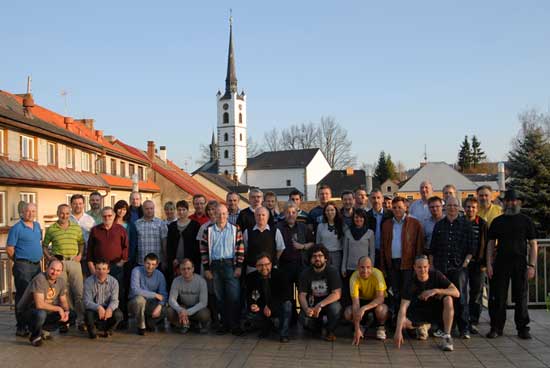
Photo 2: Participants of our most recent meeting in Frymburk (2013)
We celebrate today the10th anniversary of ČMSSRF thanks to the dedication of two organizations – CEZ a.s. and the Czech Nuclear Society (CNS). The Czech Nuclear Society, which recognized the importance of exchanging information and founded the Section of Reactor Physics as an independent part within its organization, supported us financially too by paying the cost of the conference hall rental and the coffee breaks. At the same time we also present our results during its conferences, in publications and via the website. So thanks to CNS we are looking forward to our next meeting, which will be organised by CEZ and will take place near Prague.
http://www.euronuclear.org/e-news/e-news-41/romania.htm

The Romanian Nuclear Energy Association, AREN, recently organised, together with the Romanian Atomic Forum (ROMATOM), the annual essay competition entitled The Atom – Our Friend and the 18th edition of the Alexandru Ene Drawing Competition. Both began back in early April, and by the end of May students from across the country had sent in their literary and artistic creations as entries to both competitions.
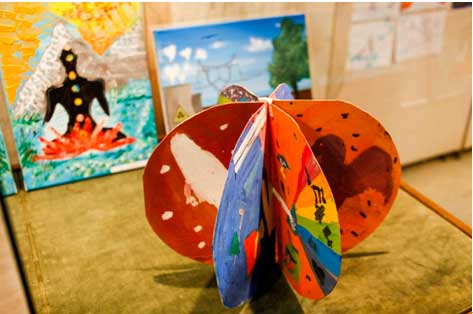
The Alexandru Ene Drawing Competition took place at the national level and followed the same format as for the previous edition, addressing educational establishments separately according to their profile, whether general or art specialized schools. In order to ensure wide-scale participation students were categorised not only according to their school profile but also according to their age group. So, the general schools profile consisted of three age groups, 7-10 years, 11-14 years and 15-19 years. For the art schools there were only two age groups: 11-14 years and 15-19 years.
On the whole, this year's edition featured 272 drawings, of which 76 schools came from art schools/high schools and 196 from general schools. This year’s essay writing competition registered its largest ever number of entries: 67.
Each entry featured a “transfiguration” of science and knowledge received from their teachers, either in the form of a drawing or painting (many of them were real works of art) or essays that put into vivid words and narrative the most unusual, challenging and sometimes abstract ideas and descriptions. Each year children are becoming more and more creative, non-conformist in their approach, which attracted the attention of the jury that had a tough time deciding which ones were the best.
The final judgment was left, as always, to the specialists in the fields of nuclear sciences, architecture, fine arts, language and communication and advertising.
The competition culminated with the awarding of the prizes to the winners and with an exhibition of the winning entries at the Parliament Palace’s Constantin Brancusi Exhibition Hall. The works were exhibited throughout the week of 3-7 June, where they could be admired by all those who visited the exhibition halls at the Palace of Parliament, whether Romanians or not.
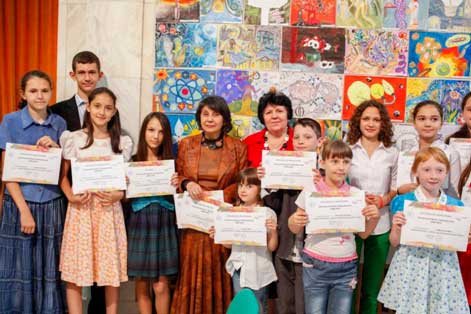
The winners’ classification and the award-winning essays or pictures from the exhibition can be viewed by visiting aren.ro/evenimente/concurs-de-desene-si-eseuri/ or the Facebook page of AREN.
http://www.euronuclear.org/e-news/e-news-41/researchers-day.htm

On 17 May, AREN and the Nuclear Physics Institute (IFIN-HH) gave pupils from Bucharest the opportunity to become researchers for one day during a tour of the Magurele Nuclear Research Platform. This visit was aimed at making nuclear science available and easy to understand for pupils and teachers and at presenting the future projects of the Reseach Institute, which will offer employment opportunities in the future.
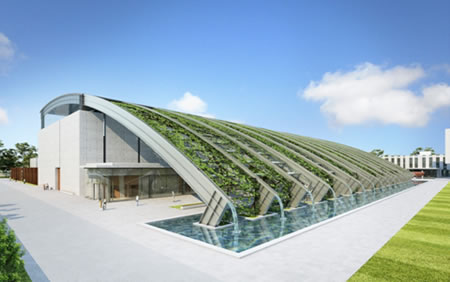
The Magurele Platform will house an ambitious physics project called ELI-NP (Extreme Lightning Infrastructure - Nuclear Physics), which is a large laser installation built together with Hungary and the Czech Republic. 45 pupils visited the nuclear physics reactor, which is currently undergoing decommissioning and the site of the future laser installation.
AREN has been a constant supporter of public information and educational activities dedicated to the younger generation and designed to expose the myths and false conceptions regarding nuclear power that still persist.
http://www.euronuclear.org/e-news/e-news-41/uclan.htm

Vice Chancellor Malcolm McVicar welcomed more than fifty delegates, including many senior managers from across the nuclear industry, to this stimulating and thought-provoking conference.
Professor Laurence Williams (UCLAN) presented a strong argument for a change from the historic approach, where the 3Ss were considered as separate issues, to one where the synergies are recognised and the three areas are coordinated within all life-cycle stages. Professor Williams explored the challenges of such a change in respect of licensee responsibilities and organisation, the separate cultures, beliefs and values of the safety and security communities and the approach to risk evaluation. In conclusion, he felt that this was both an international as well as a national issue and that the IAEA should provide a lead.
Deputy Chief Inspector Mark Bassett from the Office of Nuclear Regulation (ONR) explored some of the challenges to regulatory integration arising from differences in the underpinning legislation and regulatory frameworks for safety and security. From 2007, ONR has had civil nuclear security and the UK safeguards added to its traditional safety responsibilities and work is progressing towards an integrated approach. He said the real issue is cultural, not legal.
Zdenka Polovja from the EU’s Joint Research Centre explored the synergies between safety and security and the issues this generated. Using common technology to address both safety and security was an approach that could be desirable in satisfying Gen IV design goals.
An interesting perspective on the integration of safety and security was presented by Dr Roger Howsley, the Director of the World Institute for Nuclear Security (WINS). He outlined the work of WINS, its best practice guides and the launch of the WINS Academy to provide demonstrable competence in the area of security. Whereas most nuclear company Boards have sub-committees and representation on finance, environment and safety, very few do on security. He sought to shift the culture of security being an issue for the state to one that is a prime responsibility of the duty holder, with a commitment to regular assurance reporting with transparency and a move to outcome based regulation with demonstrable duty holder competence.
Mel Draper, the ex-Head of Non-Proliferation Policy at DECC gave an informative outline of the structure and history of the Non-Proliferation Treaty, with a focus on the Article that encourages the “fullest possible” peaceful use of nuclear energy. This is the vehicle through which, at the related international review conferences, the synergies of the 3Ss are being increasingly emphasised with IAEA in the lead role.
An insight into the role and strategy of the UK’s Civil Nuclear Constabulary as an armed response force, which is funded by the industry, was given by its Chief Constable Mike Griffiths. Its mission, to deter, defend, deny and recover was outlined. The need to build in security as well as safety from the start was emphasised and the need to consider overlapping safety and security emergency exercises was suggested.
Dave Cliff, Licensing Manager for Westinghouse UK’s AP1000, noted that safety and security integration was a challenge as maintaining the standard design was a priority and the two issues had been treated in isolation.
A lively and challenging presentation on the 3S interfaces in operation from Dr Andy Spurr, Managing Director of Nuclear Generation for EDF Energy, rounded up the presentations. Contrasting with the weak regulatory and corporate governance systems in Japan that allowed the Fukushima disaster to happen, Dr Spurr said that an independent and robust regulator was essential but was not the last layer of the defence in depth. The leadership and governance arrangements that achieved a sufficient self regulatory outcome should be there with or without a regulator. He concluded with a challenge – is the drive to achieve ever lower risk frequencies undermining safety, as it can have a negative effect on culture?
The subsequent panel discussion reflected on a final remark by Dr Spurr – the challenge in safety and security is to allow courage and judgement, which is only achieved if there is openness and transparency. Secrecy must never be a cover for incompetence and ways need to be found that allow operational experience feedback to address security as well as safety.
All the speaker presentations are on the UClan web site and for further information contact Geoff Vaughan at gvaughan@uclan.ac.uk
http://www.euronuclear.org/e-news/e-news-41/sien.htm

SIEN is the traditional conference organized by AREN, under the aegis of ENS, with the support of traditional partners such as the Romanian Atomic Forum and the Romanian National Representative of the World Nuclear Council (WEC) . The theme of the conference is “Nuclear power – Milestones on the Path to Sustainability”, (ROMATOM) which aims at debating the future of nuclear power in Europe taking into account recent events in Europe and elsewhere. The program of the conference will include technical sessions and interactive workshops, among which one organized by the Young Generation Network and one organized by Women in Nuclear. The conference will end with two technical tours which will give the participants the opportunity to chose between Cernavoda NPP and the Pitesti Nuclear Fuel Plant and research facility.
For more information and registration, please visit www.sien.ro.
http://www.euronuclear.org/e-news/e-news-41/ens-ygn.htm

ENS-YGN recently announced that there had been changes at the top within the otranisation. ENS NEWS is pleased to share with you the following message from the outgoing ENS-YGN Chairman.
(Editor-in-Chief).
Dear All,
I would like to inform you that on 16 June, ENS-YGN held its second Core Committee Meeting for 2013, in Stockholm, Sweden.
During the CCM elections tok place and I am pleased to announce that the new ENS-YGN Chairman is Milo Alani from Sweden. The new Co-Chairwoman is Eileen Radde from Austria.
I would like to take this opportunity to wish them both the very best of luck and thank you all for the support and very good cooperation that you gave me during my mandates as ENS-YGN Co-Chairperson and Chairperson.
My ENS-YGN e-mail (andrei.goicea@euronuclear.org) will still be valid for one year and as alternative you can also use the following e-mailaddress: andrei.goicea@gmail.com
Best Regards,
Andrei Goicea
http://www.euronuclear.org/e-news/e-news-41/iync.htm

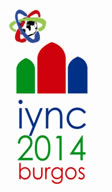 |
6 – 12 July 2014 in Burgos, Spain |
http://www.euronuclear.org/e-news/e-news-41/aren.htm

From May 22 - 24, the Nuclear Research Institute in Pitesti organized the international conference – Nuclear 2013 – which has established itself as a regular fixture in the nuclear research and industry events calendar. During the conference the Young Generation Network of the Romanian Nuclear Energy Association (AREN) organized a round-table entitled: Nuclear projects under development – opportunities for young specialists. The aim of the event was to present ongoing projects in the field of nuclear research, physics, nuclear power plant construction and the possibilities for employment offered by these projects in the future.
It is a well-known fact that the nuclear industry at the global level is confronted with the problem of the ageing of related specialists and with a reduction in the number of graduates from the technical universities that could replace them. AREN-YG is committed to attracting young people to the nuclear field and considers that one of the most motivating facts behind considering a nuclear career is the opportunity for employment that the nuclear industry represents, especially given the current global economic crisis. The projects presented during the round table focused on real opportunities for young people and also gave the speakers a chance to emphasize the requirements that the young generation needs to fulfill in order to secure employment and also to describe the training programmes currently being offered by companies. The following projects were presented:
The ELI-NP laser project, which will be built by IFIN-HH at Magurele, in cooperation with research institutes from the Czech Republic and Hungary. The project was presented by Ioan Ursu, a Director at IFIN-HH
The detritiation station, which will be built at Cernavoda NPP by ICSI RM, in Valcea. The presentation was given by Liviu Stefan from ICSI
The Generation IV reactor ALFRED, which has been developed by SCN Pitesti, which was presented by Mr. Marian Constantin
A report on the adaptation of the educational programmes of the Politehnica University of Bucharest to the new requirements of the projects under development, given by Gabriel Pavel.
The round table was attended by students from the Politehnica University of Bucharest, the University of Pitesti and by other young nuclear professionals at the beginning of their careers.
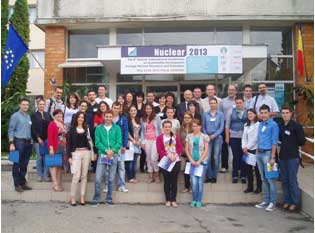
http://www.euronuclear.org/e-news/e-news-41/runermark-award.htm

Finnish Nuclear Society Young Generation (FNS-YG) is proud to inform that Professor Emeritus Heikki Kalli has received the 2013 Jan Runermark Award. He was nominated by FNS-YG for his work supporting young nuclear professionals over the last few decades.
Heikki Kalli graduated from Helsinki University of Technology 1963 in technical physics. He received his Ph.D in 1974. The dissertation topic was Monte Carlo Studies On Neutron Transport.
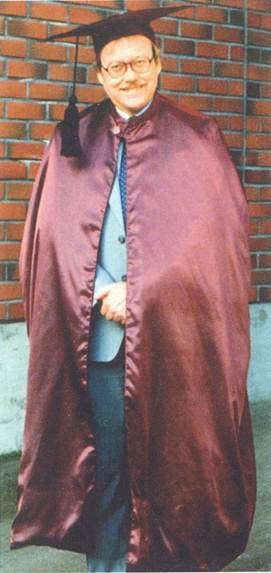 |
During 1975-1979, Heikki Kalli spent his time in Saclay, France, in Service d´Etudes de Réacteurs et de Mathematique Appliquees (SERMA), excluding one year which he was in Los Alamos. After that he transferred to Lappeenranta University of Technology (LUT) where he was the associate professor in nuclear engineering during 1979-1989, and after that the professor in nuclear engineering until 2001 when he retired. He is also a docent of nuclear engineering at the Helsinki University of Technology. Professor Kalli has been an active member of national and international nuclear societies. He has been a member of organizations and programme committees of several international congresses and expert or external advisory groups for EAURATOM and OECD/NEA. Professor Kalli is a member of multiple nuclear Societies e.g. Finnish Nuclear Society (honorary member), Société Francaise d'Energie Nucléaire, American Nuclear Society, Finnish Physical Society, Association Franco-Finlandaise pour la Recherche Scientifique et Technique and Finnish Academy of Technology. Above all, professor Kalli is an inspiring educator. He has had a long and vast career in the center of nuclear education in Finland. He has been an inspiration for many |
|---|
engineers in the nuclear field. He created a compact and large range package for M.Sc. courses in nuclear engineering, which has been a good backbone for solid and wide knowledge for nuclear engineers. He has also been an active participant in FNS-YG activities. For these reasons he was the "Lecturer of the Year 1987".
Professor Kalli has always highlighted the education and transfer of know-how between generations. He brought the problem of increasing retirement and need for new generations into a wider discussion. He has showed the way and inspired younger generations to go abroad and hence widen the professional perspectives. He also introduced tens of foreign exchange students, master's workers and researchers into the university's nuclear research.
The Finnish Nuclear Society Young Generation wants to thank professor Heikki Kalli for his support and great work for Finnish Nuclear Society.
Congratulations and thank you Heikki!
http://www.euronuclear.org/e-news/e-news-41/atoms-future.htm

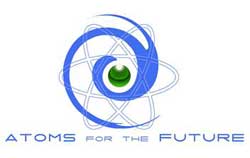
Atoms for the Future is a key international event organised every year by the French Nuclear Energy Society - Young Generation Network (SFEN JG).
The 2012 edition was dedicated to plant operation and welcomed very high level speakers such as Luc Oursel, AREVA’s President and Chief Executive Officer; André-Claude Lacoste, former Chairman of the French Nuclear Safety Authority, etc. About 250 students and young professionals from the nuclear industry participated in the event.
After the success of the event the SFEN-JG decided to organise the 2013 edition. It will be held from 21-24 October and will be dedicated to the topic of Nuclear Energy and the Power Grid. It will consist of a 2-day conference in Paris and of 2 days of visits including one to an EDF NPP, another to the RTE dispatching center and a third one to an EDF research center. The presentations will feature, among speakers, Dominique Minière, EDF Senior Vice President and SFEN President; Christophe Béhar, CEA’s Director of the Nuclear Energy Division and Jean-Baptiste Galland, ERDF’s Director of Strategy and Smart Grids.
Registration is now open! (the number of participants is limited):
/www.sfen.fr/21-to-24-october-2013
For more information on this event and the up-to-date programme of presentations: www.sfenjg.org/Atoms-for-the-Future-2013
For any questions go to: atomsforthefuture@sfenjg.org
http://www.euronuclear.org/e-news/e-news-41/l-3.htm

MONTREAL, May 6, 2013 – L-3 MAPPS announced today that it has won an upgrade contract from Daya Bay Nuclear Power Operations and Management Co., Ltd. (DNMC) to equip the Ling Ao Phase II full scope simulator with a severe accident simulation model to enhance training scenarios that simulate degraded reactor core conditions. The project, which underscores L-3 MAPPS’ continued commitment to DNMC, will commence immediately and is slated to be in service at the beginning of 2014.
“Since the Fukushima accident in 2011, we have seen increased demand for severe accident simulation on real-time nuclear plant training simulators,” said Michael Chatlani, vice President of Marketing & Sales for L-3 MAPPS Power Systems and Simulation. “This upgrade project is important to L-3 MAPPS as it will allow us to field exciting new simulation products and solutions in the near term and to once again provide DNMC with a successful solution.”
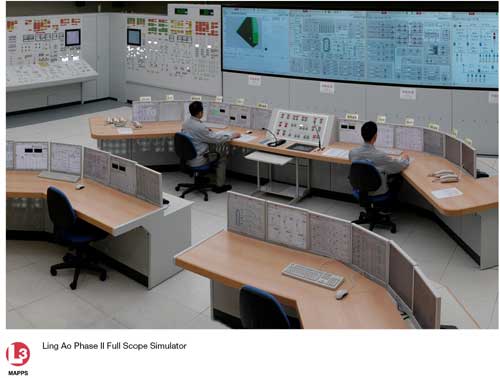
L-3 MAPPS will connect the Electric Power Research Institute’s (EPRI) Modular Accident Analysis Program (MAAP5) to the Ling Ao Phase II simulator. MAAP5 is a software program that performs severe accident analysis for nuclear power plants, including assessments of core damage and radiological transport.* The simulator will also be equipped with new 2-D and 3-D animated, interactive visualizations of the reactor vessel, containment building and spent fuel pool to provide operators with additional insight into the behavior of the plant during severe accidents. The 2-D graphics will be enabled with L-3’s Orchid® Control System and 3-D visuals will be powered by Bridgeworks© from TriLink Systems.
In addition to the normal operations and abnormal, off-normal and emergency event training for which the simulator is currently extensively used, the upgraded Ling Ao Phase II simulator will be used for training scenarios relating to degraded reactor core conditions that result in fuel melting, including cladding oxidation and hydrogen generation, vessel failure, containment failure and fission product release.
The Ling Ao Phase II nuclear plant, owned by Ling Dong Nuclear Power Company, comprises the first two CPR1000 nuclear generating units that were put into commercial operation – the first unit in September 2010 and the second in August 2011. The CPR1000 is a Chinese standard design featuring a 1,080-megawatt (MWe) three-loop pressurized water reactor (PWR). The Ling Ao Phase II full scope simulator, built by L-3 MAPPS in cooperation with AREVA and Siemens, was put into service in August 2009.
L-3 MAPPS, a division of L-3 Marine & Power Systems, has over 30 years of experience in pioneering technological advances in the marine automation field and over 40 years of experience in delivering high-fidelity power plant simulation to leading utilities worldwide. In addition, the company has more than four decades of expertise in supplying plant computer systems for Canadian heavy water reactors. L-3 MAPPS also provides targeted controls and simulation solutions to the space sector. To learn more about L-3 MAPPS, please visit the company’s website at www.L-3com.com/MAPPS.
Comprising 25 operating companies, L-3 Marine & Power Systems (L-3 M&PS) is a worldwide leader in maritime automation and control, navigation, communications, dynamic positioning, and power distribution and conditioning for the U.S. Navy, allied foreign navies and commercial customers worldwide. L-3 M&PS also produces full-fidelity simulators for increased operator proficiency, resulting in safe operations for leading international utilities and ship operators. With over 85 locations in 19 countries, L-3 M&PS is a cohesive, global partner with extensive capabilities and a proven track record in delivering the highest level of technology, service and integration. To learn more about L-3 Marine & Power Systems, please visit the company’s website at www.L-3com.com/MPS.
Headquartered in New York City, L-3 employs approximately 51,000 people worldwide and is a prime contractor in C3ISR (Command, Control, Communications, Intelligence, Surveillance and Reconnaissance) systems, platform and logistics solutions, and national security solutions. L-3 is also a leading provider of a broad range of electronic systems used on military and commercial platforms. The company reported 2012 sales of $13.1 billion. To learn more about L-3, please visit the company’s website at
www.L-3com.com.
Except for historical information contained herein, the matters set forth in this news release are forward-looking statements. Statements that are predictive in nature, that depend upon or refer to events or conditions or that include words such as “expects,” “anticipates,” “intends,” “plans,” “believes,” “estimates,” “will,” “could” and similar expressions are forward-looking statements. The forward-looking statements set forth above involve a number of risks and uncertainties that could cause actual results to differ materially from any such statement, including the risks and uncertainties discussed in the company’s Safe Harbor Compliance Statement for Forward-Looking Statements included in the company’s recent filings, including Forms 10-K and 10-Q, with the Securities and Exchange Commission. The forward-looking statements speak only as of the date made, and the company undertakes no obligation to update these forward-looking statements.
# # #
*A valid license to MAAP5 from EPRI is required prior to a customer being able to use MAAP5 with Licensee’s simulator products. EPRI does not endorse any third-party products or services.
Bridgeworks is a trademark of Bridgeborn, Inc.
Orchid is a trademark of L-3 Communications MAPPS Inc. All other products are trademarks of their respective companies.
http://www.euronuclear.org/e-news/e-news-41/EHRO-N.htm

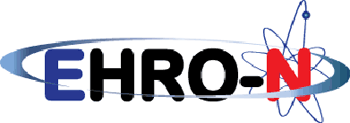
The report ‘Top-Down Workforce Demand Extrapolation from Nuclear Energy Scenario's’ is now available on the website of EHRO-N, the European Human Resource Observatory for the Nuclear Energy Sector.
Based on existing nuclear energy scenarios, the report provides an analysis of the required workforce for operation and construction of nuclear power plants in Europe during the coming 30 years. Depending on the considered scenario and the size of the considered new build, about 95 to 160 reactors will have to be constructed to replace the existing reactors and fulfill the slightly growing nuclear energy demand. During construction, a peak workforce of about 70000 can be expected.
Apart from this, the report also provides insight in the new workforce which replaces the existing workforce which is retiring. From this assessment, it can be concluded that we face a big challenge the coming 10 to 15 years. The timing of this peak workforce may be shifted by life time extension of the current reactor park.
The full report can be found at the website of the EHRO-N project: ehron.jrc.ec.europa.eu/.
http://www.euronuclear.org/e-news/e-news-41/mstf.htm

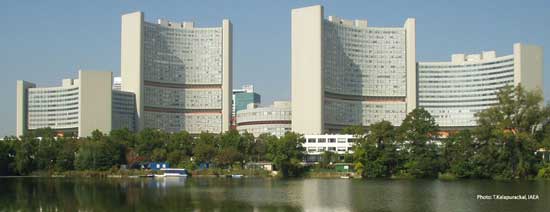
From 20-22 November 2013, in Vienna (Austria), the IAEA/FORATOM Management System Workshop entitled: " Journey to Excellence in a Changing Environment " will take place. The Workshop is the twelfth in a series that the IAEA and FORATOM have organised jointly to raise awareness, increase understanding and promote the application of the IAEA Safety Standards on management systems.
Each day of the Workshop will tackle an important issue related to an organisation’s management system: Day One: Practical Solutions for the Integration of Elements in the Management System and Evaluation of its Performance; Day Two: How to Evolve your MS in a Changing Environment; Day Three: Lessons learned from an emergency situation.
The workshop will encourage an exchange of practical ideas and strategies and help to identify common difficulties, possible solutions and good practices with regard to establishing, implementing, assessing and continually improving a management system.
For further information and to register for the Workshop, visit: www.mstf2013.org or contact: Guy Parker, Institutional Affairs Senior Manager, FORATOM guy.parker@foratom.org
http://www.euronuclear.org/e-news/e-news-41/gentle.htm

The GENTLE (Graduate and Executive Nuclear Training and Lifelong Education) Project is a new initiative in support of nuclear training and education organised within the 7th Framework Programme of the European Commission. It brings together leading European universities in the field of nuclear training and education and national and international research institutions with the aim of creating a sustainable lifelong E&T (education and training) programme in the field of nuclear fission technology that meets the needs of European stakeholders (industry, research organisations, etc).
The GENTLE Project's programme is based on three E&T tools. Firstly, student research projects will enable students from the participating universities to get hands-on experience in some of Europe's unique and specialised laboratories and to participate in cutting-edge research. Secondly, intersemester courses will be organised for graduate and post-graduate students studying specific topics that are generally not part of the academic programme, such as nuclear safeguards and forensics, nuclear fuel, or nuclear decommissioning. Thirdly, an Executive Master's Course for young professionals, particularly those who have no nuclear education background, will be initiated to enhance their knowledge of nuclear reactors and fuel cycles.
The GENTLE Project had its kick-off meeting at the Technical University of Delft, in the Netherlands, in March of this year, during which a dialogue with the stakeholders took place. This gave rise to a set of recommendations that are currently under review. The GENTLE project will run from 2013 to 2017.
http://www.euronuclear.org/e-news/e-news-41/ecvet.htm

The European Human Resources Observatory – Nuclear (EHRO-N), through ts operating agent, the Institute for Energy and Transport (IET) of the Joint Research Centre (JRC), European Commission (EC), initiated in 2011 the preparation of a so-called “nuclear job taxonomy.” This answered a request from DG RTD and DG EAC to promote the implementation of the European Credit System for Vocational Education and Training (ECVET)1 in the nuclear sector.
The nuclear job taxonomy aims to create an inventory of the job positions typically present in a nuclear power plant (NPP) - encompassing its three life-cycle phases - with a detailed account of the requirements needed to perform each of those jobs. Adopting an approach in keeping with ECVET principles, those requirements are expressed solely in terms of competence.
A catalogue of competences built up during the development of the taxonomy has reached a statge where it can be considered to be an additional separate outcome of the project.
Once completed, the taxonomy shall offer a number of potential benefits, key among which will be the creation of a reference document for the description of qualifications in terms of learning outcomes (L.O.).
As a reference document for the description of qualification of L.O, the taxonomy can guarantee the harmonization of ECVET's implementation in the nuclear field, favouring the increase of international mobility, saving costs and effort and tackling the actual human resources defficiency in this field.
Lacking the necessary in-house workforce and know-how and also driven by the need to provide a trans-European dimension to the project, the IET launched, starting in October 2011, a series of technical workshops targeting experts in the area of nuclear human resources, training and education. A part of these meetings has been devoted to the dissemination of the ECVET initiative and the specifications relevant for the task. As awareness grew, the focus gradually shifted towards technical work that consisted of the preparation of job lists and job profiles. At the same time, the design concept of the taxonomy has been revised and progressively fine-tuned.
As the project has gained visibility, its impact has grown, a fact reflected in the increasing participation in the workshops.
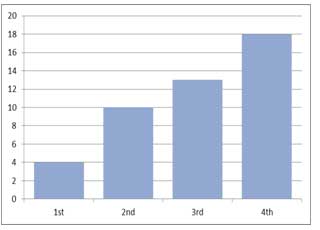
Figure 1: number of participants in the ECVET Workshops
It is worth mentioning the high rate of continuity: around two thirds of the contributors to each of the first three meetings attended the following one. This gives a positive indication of the registered interest in the project, which has generated a small but committed community of participants.
In adition to the total figures, the diversity of the contributors' country and type of organisation were necessary conditions for ensuring an adequacte outcome on an EU-wide level. As shown in the figures below, this diversity has been reasonably well achieved.
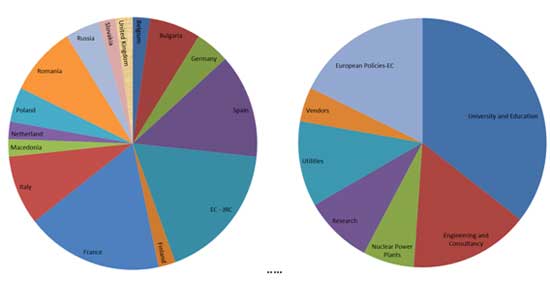
Figure 2: Participations per type of organisation Figure 3: Participations per country
After several revisions, the work methodology for the preparation of the job profiles has been fixed as a three-step workflow, consisting of draft preparation, individual review and group review for every profile. Although the job lists are subject to continuous revision, when you consider that there are 155 positions at the moment, this means 465 tasks in total, of which around fifty per cent has been completed. Around one in nine positions has at least received a first draft
Simultaneously to the preparation of the profiles, the concept has been discussed and revised in every workshop, leading to successive modifications of the profile template. The present model aims at providing a very concise formulation of the job requirements, which are individually marked with the European Qualifications Framework (EQF)2 descriptors. Being competence-focused the reference to associated academic levels has recently been removed. According to the conclusions of the last workshop a more systematic terminology and categorisation shall be implemented to define the job titles. On the other hand, the Competence Catalogue contains near 650 entries. The IET is seeking an expert partner to carry out the necessary reviewing, structuring, and enlargement.
The finalisation of the job profiles still requires an important investment of resources. The remaining tasks to be carried out are to a large extent reliant on group reviews, which are significantly time-consuming.
Regarding the sectors involved in the project, so far the presence of the scientific and educational sectors prevails: universities, training providers and research centres. It would be desirable to increase the presence of the industrial sector in the process, particularly NPP operators that will be the final users of the human resources trained under the ECVET system. Moreover, the project has been partly hindered by inadequate input relating to NPP design and construction activities, which caused the slow progress of the new build phase.
Also a widening in the scope of the taxonomy could be undertaken sometime in the near future to incorporate nuclear activities related to fission generation that are outside the NPP, such as regulatory bodies and research.
Finally, after the completion of the taxonomy it will be necessary to submit the results for consensus among all stakeholders that are part of the nuclear field including: nuclear authorities (TSO's), educational institutions (universities and VET providers) and industry (particularly NPP operators).
The resolution of these potential challenges could benefit the implementation of ECVET in the nuclear field and thereby help bridge the human resources gap that currently persists in Europe's nuclear industry.
Read more at ehron.jrc.ec.europa.eu/job-taxonomy
1ECVET Recommendation:
eur-lex.europa.eu/LexUriServ/LexUriServ.do?uri=OJ:C:2009:155:0011:0018:EN:PDF
2EQF Recommendation:
eur-lex.europa.eu/LexUriServ/LexUriServ.do?uri=OJ:C:2008:111:0001:0007:EN:PDF
http://www.euronuclear.org/e-news/e-news-41/win-germany.htm

 WiN Germany Prize 2013
WiN Germany Prize 2013An award in recognition of outstanding projects and scientific work carried out in the field of nuclear energy
True to tradition 2013 will see the presentation of the annual WiN (Women in Nuclear) Germany Prize. It is aimed at young talented individuals working in the field of nuclear energy.
The prize consists of 1,500 Euros and free participation in the Retaining Competence Workshop taking place during the 2014 Annual Nuclear Energy Congress
For further information contact:
WIN Germany e.V.
Robert-Koch- Platz 4
10115 Berlin
info@women-in-nuclear.de
www.women-in-nuclear.de
http://www.euronuclear.org/e-news/e-news-41/andra.htm

The aims of this EF4 are:
Bring forward new projects in a bottom-up approach in the framework of the deployment of activities described in the SRA/DP (Strategic Research Agenda)
Identify new subjects of collaboration related to SNETP (Sustainable Nuclear Energy Technology Platform) future needs
Identify subject of common interest with Technical Support Organisations (TSOs) through SITEX (Sustainable network of Independent Technical EXpertise for radioactive waste Disposal)
Inform on working groups activities and EC projects
Develop new R&D programmes on stakeholder involvement
To fulfill these objectives, 5 Working Groups are planned and will allow discussion on priorities and new areas of interest:
WG1: Cement
WG2: Monitoring
WG3: New Waste Type, in collaboration with SNETP
WG4: RD&D TSO’s needs: the view of SITEX
WG5: Microbiological Studies
For this EF4, the idea is to focus on new ideas that could complement our SRA priorities through a bottom-up approach and to involve in a more efficient way new actors of the RD&D. That’s why all participants are encouraged to send their contributions/suggestions and ideas.
To register and submit a presentation, this Registration & application form needs to be filled in and sent to the Secretariat secretariat@igdtp.eu.
The call for presentation will close on August 31. Registrations are open until September, 30.
For more information on EF4, I invite you to visit our website: igdtp.eu.
Do not hesitate to disseminate this news to all parties that can be interested in this event.
I am looking forward to seeing you in Prague
http://www.euronuclear.org/e-news/e-news-41/other-conferences.htm


8 - 12 September 2013
Brussels, Belgium
more
![]()
9 - 12 September 2013
Bled, Slovenia
more
9 - 13 September 2013
Ispra, Italy
more

15 - 19 September 2013
Charlotte, NC, USA
more

18 - 21 September 2013
Sunny Beach, Bulgaria
more

25 - 27 September 2013
Reus, Spain
more
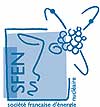
Joint International Conference on "Supercomputing in Nuclear Applications + Monte Carlo"
27 - 31 October 2013
Paris, France
more
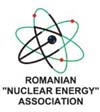
10 - 14 November 2013
Bucharest, Romania
more

11 - 13 November 2013
Prague, Czech Republic
more

2nd International Symposium on Cement-based Materials for Nuclear Wastes
3 - 6 June 2014
Avignon, Popes’ Palace, France
more
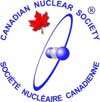
24 - 28 August 2014
Vancouver, Canada
more

14 - 14 September 2014
Sendai, Japan
more

Contribution of Materials Investigations and Operating Experience to LWRs’ Safety, Performance and Reliability
14 - 18 September 2014
Avignon, Popes’ Palace, France
more
![]()
28 September - 3 October 2014
Kyoto, Japan
more
![]()
26 - 31 October 2014
Sapporo, Japan
more
http://www.euronuclear.org/e-news/e-news-41/Member-Societies.htm

Austrian
Nuclear Society |
Belgian
Nuclear Society |
Bulgarian
Nuclear Society |
Croatian
Nuclear Society |
Czech Nuclear Society |
Finnish
Nuclear Society |
French
Nuclear Energy Society (SFEN) |
German
Nuclear Society (KTG) |
Hungarian
Nuclear Society |
The
Israel Nuclear Society |
Italian
Nuclear Association |
Lithuanian
Nuclear Energy Association |
Netherlands Nuclear Society |
The Nuclear Institute |
Nuclear
Society of Russia |
Nuclear
Society of Serbia |
Nuclear
Society of Slovenia |
Polish
Nuclear Society |
Romanian
Nuclear Energy Association (AREN) |
Slovak
Nuclear Society |
Spanish
Nuclear Society |
Swedish
Nuclear Society |
Swiss
Nuclear Society |
http://www.euronuclear.org/e-news/e-news-41/Corporate-Members.htm
Links to ENS Corporate Members |
AF-Colenco Ltd., Nuclear Technology
Department |
Alpiq Ltd |
Alpiq Suisse Ltd. |
Andritz AG |
Ansaldo Nucleare S.p.A |
AREVA NP GmbH |
Atomic Energy Council (AEC) |
Atomic Energy of Canada Limited (AECL) |
Atomexpo LLC |
Atomtex SPE |
Axpo AG |
BKW FMB Energie AG |
Chilean Nuclear Energy Commisssion |
Electrabel, Generation Department |
NV Elektriciteits-Produktiemaatschappij
Zuid-Nederland EPZ |
Electricité de France (EDF), Communication Division |
Euro Nuclear Services BV |
E.O.N Kernkraft GmbH |
ENUSA Industrias Avanzadas SA |
EXCEL Services Corporation |
GE Nuclear Energy |
IEA of Japan Co. Ltd |
Kernkraftwerk Gösgen-Däniken
AG |
Kernkraftwerk Leibstadt AG (KKL), |
L-3 Communications MAPPS Inc. |
Linn High Therm GmbH |
Elektroinstitut Milan Vidmar |
NRG Arnhem |
NRG Petten |
NUKEM Technologies GmbH |
ONET TECHNOLOGIES |
MVM Paks Nuclear Power Plant Ltd |
Paul Scherrer Institute |
Polimaster Ltd |
Siempelkamp Nukleartechnik
GmbH |
|
SKB (Swedish Nuclear Fuel and Waste Management
Company) |
Studiecentrum voor Kernenergie, Centre d’Etude
de l’Energie Nucléaire SCK/CEN |
Synatom |
Taiwan Power Company (Taipower) |
Taiwan Atomic Energy Council (AEC) |
Teollisuuden Voima Oyj / Industrial Power
Company Ltd (TVO) |
Tractebel Engineering S. A. |
UNESA |
Urenco Limited |
Vattenfall AB |
VNS – Vinçotte Nuclear Safety |
VTT Nuclear |
Westinghouse Electric Company |
World Association of Nuclear Operators
(WANO), |
http://www.euronuclear.org/e-news/e-news-41/editorial.htm

Editorial Staff:
Mark O’Donovan, Editor-in-Chief
Contributors to this Issue:
Daneš Burket (Czech Nuclear Society)
Enrique Pastor Calva (Spanish Nuclear Society)
Kirsten Epskamp (ENS)
Andrei Goicea (ENS YGN)
Zoltan Hozer (Hungarian Nuclear Society)
Emilia Janisz (ENS)
Rizea Lavinia (AREN)
Juraj Klepáč (SNUS)
Alicia Lacal Molina (European Commission)
Mika Pikkarainen (FNS-YG)
Jean-Pol Poncelet (ENS)
César Chenel Ramos (European Commission)
Ferry Roelofs (NRG)
Vladimir Slugen (Slovak Nuclear Society)
Realisation:
Marion Brünglinghaus
Avenue des Arts 56, BE-1000 Brussels
Phone +32 2 505 30 50 - Fax: +32 2 502 39 02
E-mail: info@euronuclear.org - http://www.euronuclear.org
The ENS News is a quarterly publication, in electronic
form only.
Copyright notice ©2013 European Nuclear Society.
Reproduction is authorised provided that the ENS News is acknowledged as the
source – except where otherwise stated.
![]()
© European Nuclear Society, 2013